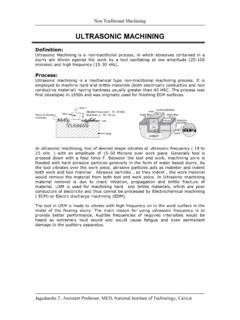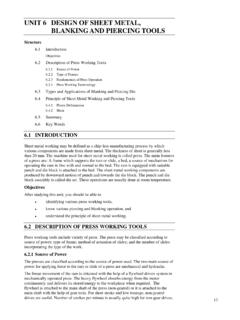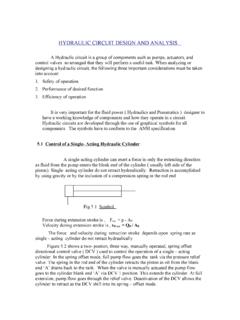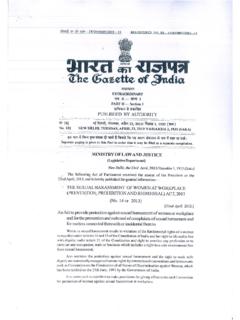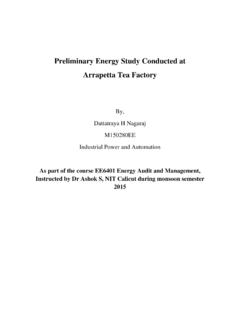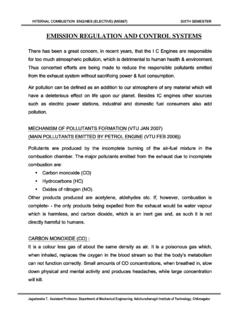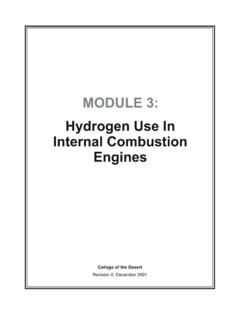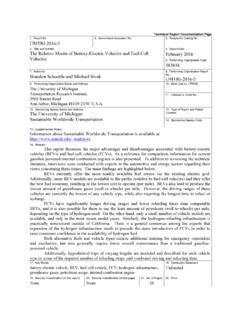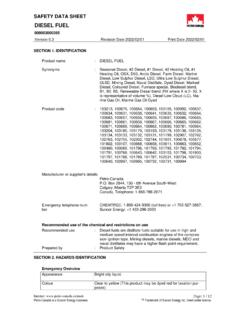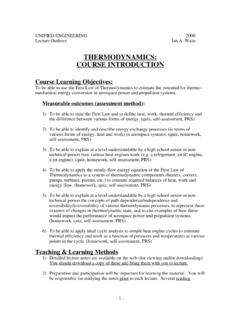Transcription of COMBUSTION PROCESS IN SI ENGINES
1 internal COMBUSTION ENGINESINTERNAL COMBUSTION ENGINESINTERNAL COMBUSTION ENGINESINTERNAL COMBUSTION ENGINES (ELECTIVE) (ME667)(ELECTIVE) (ME667)(ELECTIVE) (ME667)(ELECTIVE) (ME667) SIXTH SEMESTER SIXTH SEMESTER SIXTH SEMESTER SIXTH SEMESTER Jagadeesha T, Assistant Professor, Department of Mechanical Engineering, Adichunchanagiri Institute of Technology, Chikmagalur COMBUSTION PROCESS IN SI ENGINES COMBUSTION may be defined as a relatively rapid chemical combination of hydrogen COMBUSTION may be defined as a relatively rapid chemical combination of hydrogen COMBUSTION may be defined as a relatively rapid chemical combination of hydrogen COMBUSTION may be defined as a relatively rapid chemical combination of hydrogen and carbon in fuel with oxygen in air resulting in liberation of energy in the form of and carbon in fuel with oxygen in air resulting in liberation of energy in the form of and carbon in fuel with oxygen in air resulting in liberation of energy in the form of and carbon in fuel with oxygen in air resulting in
2 Liberation of energy in the form of heat. heat. heat. heat. Following conditions are necessary for combusFollowing conditions are necessary for combusFollowing conditions are necessary for combusFollowing conditions are necessary for COMBUSTION to take placetion to take placetion to take placetion to take place The presence of combustible mixtureThe presence of combustible mixtureThe presence of combustible mixtureThe presence of combustible mixture Some means to initiate mixtureSome means to initiate mixtureSome means to initiate mixtureSome means to initiate mixture Stabilization and propagation of flame in COMBUSTION ChamberStabilization and propagation of flame in COMBUSTION ChamberStabilization and propagation of
3 Flame in COMBUSTION ChamberStabilization and propagation of flame in COMBUSTION Chamber In S I ENGINES , carburetor supplies a combustible mixture of petrol and air and In S I ENGINES , carburetor supplies a combustible mixture of petrol and air and In S I ENGINES , carburetor supplies a combustible mixture of petrol and air and In S I ENGINES , carburetor supplies a combustible mixture of petrol and air and spark plug initiates combustspark plug initiates combustspark plug initiates combustspark plug initiates combustionionionion IGNITION LIMITSIGNITION LIMITSIGNITION LIMITSIGNITION LIMITS Ignition of charge is only possible within certain limits of fuelIgnition of charge is only possible within certain limits of fuelIgnition of charge is only possible within certain limits of fuelIgnition of charge is only possible within certain limits of fuel ----air ratio.
4 Ignition limits air ratio. Ignition limits air ratio. Ignition limits air ratio. Ignition limits correspond approximately to those mixture ratios, at lean and rich ends of scale, correspond approximately to those mixture ratios, at lean and rich ends of scale, correspond approximately to those mixture ratios, at lean and rich ends of scale, correspond approximately to those mixture ratios, at lean and rich ends of scale, where heat released by spark is no longer sufficient to iniwhere heat released by spark is no longer sufficient to iniwhere heat released by spark is no longer sufficient to iniwhere heat released by spark is no longer sufficient to initiate COMBUSTION in tiate COMBUSTION in tiate COMBUSTION in tiate COMBUSTION in neighbouring neighbouring neighbouring neighbouring unburnt mixture.
5 For hydrocarbons fuel the stoichiometric fuel air ratio unburnt mixture. For hydrocarbons fuel the stoichiometric fuel air ratio unburnt mixture. For hydrocarbons fuel the stoichiometric fuel air ratio unburnt mixture. For hydrocarbons fuel the stoichiometric fuel air ratio is 1:15 anis 1:15 anis 1:15 anis 1:15 and hence the fuel air ratio must be about 1:30 and 1:7d hence the fuel air ratio must be about 1:30 and 1:7d hence the fuel air ratio must be about 1:30 and 1:7d hence the fuel air ratio must be about 1:30 and 1:7 THEORIES OF COMBUSTION IN SI ENGINETHEORIES OF COMBUSTION IN SI ENGINETHEORIES OF COMBUSTION IN SI ENGINETHEORIES OF COMBUSTION IN SI engine COMBUSTION in SI engine may roughly COMBUSTION in SI engine may roughly COMBUSTION in SI engine may roughly COMBUSTION in SI engine may roughly divdivdivdivided into two general types: Normal and ided into two general types: Normal and ided into two general types: Normal and ided into two general types: Normal and Abnormal Abnormal Abnormal Abnormal (knock(knock(knock(knock free or Knocking).)))
6 Free or Knocking). free or Knocking). free or Knocking). Theoretical diTheoretical diTheoretical diTheoretical diagram of pressure crank agram of pressure crank agram of pressure crank agram of pressure crank angle diagram is shownangle diagram is shownangle diagram is shownangle diagram is (a(a(a(a b) is b) is b) is b) is compression PROCESS , (bcompression PROCESS , (bcompression PROCESS , (bcompression PROCESS , (b c) is c) is c) is c) is internal COMBUSTION ENGINESINTERNAL COMBUSTION ENGINESINTERNAL COMBUSTION ENGINESINTERNAL COMBUSTION ENGINES (ELECTIVE) (ME667)(ELECTIVE) (ME667)(ELECTIVE) (ME667)(ELECTIVE) (ME667)
7 SIXTH SEMESTER SIXTH SEMESTER SIXTH SEMESTER SIXTH SEMESTER Jagadeesha T, Assistant Professor, Department of Mechanical Engineering, Adichunchanagiri Institute of Technology, Chikmagalur COMBUSTION PROCESS and (ccombustion PROCESS and (ccombustion PROCESS and (ccombustion PROCESS and (c d) is an expansion PROCESS . In an ideal cycle it can d) is an expansion PROCESS . In an ideal cycle it can d) is an expansion PROCESS . In an ideal cycle it can d) is an expansion PROCESS .
8 In an ideal cycle it can be be be be seen from the seen from the seen from the seen from the diagram,diagram,diagram,diagram, the entire pressure rise during COMBUSTION takes place at the entire pressure rise during COMBUSTION takes place at the entire pressure rise during COMBUSTION takes place at the entire pressure rise during COMBUSTION takes place at constant volume , at TDC. However, in actual cycle this does not happen. constant volume , at TDC. However, in actual cycle this does not happen. constant volume , at TDC. However, in actual cycle this does not happen. constant volume , at TDC. However, in actual cycle this does not happen. RICHARD S THEORY OF S THEORY OF S THEORY OF S THEORY OF COMBUSTION .
9 Sir Sir Sir Sir Ricardo,Ricardo,Ricardo,Ricardo, known as father of engine research describes thknown as father of engine research describes thknown as father of engine research describes thknown as father of engine research describes the COMBUSTION PROCESS e COMBUSTION PROCESS e COMBUSTION PROCESS e COMBUSTION PROCESS can be imagined as if it is developing in two stages:can be imagined as if it is developing in two stages:can be imagined as if it is developing in two stages:can be imagined as if it is developing in two stages: Growth and development of a self propagating nucleus flame. ( Ignition lag)Growth and development of a self propagating nucleus flame. ( Ignition lag)Growth and development of a self propagating nucleus flame.
10 ( Ignition lag)Growth and development of a self propagating nucleus flame. ( Ignition lag) Spread of flame through the COMBUSTION chamberSpread of flame through the COMBUSTION chamberSpread of flame through the COMBUSTION chamberSpread of flame through the COMBUSTION chamber THREE STAGE OF THREE STAGE OF THREE STAGE OF THREE STAGE OF COMBUSTIONCOMBUSTIONCOMBUSTIONCOMBUSTION (VTU July/Aug 05/Feb 06/(VTU July/Aug 05/Feb 06/(VTU July/Aug 05/Feb 06/(VTU July/Aug 05/Feb 06/July 06)July 06)July 06)July 06) According to Ricardo, There are three stages of COMBUSTION in SI engine as shown According to Ricardo, There are three stages of COMBUSTION in SI engine as shown According to Ricardo, There are three stages of COMBUSTION in SI engine as shown According to Ricardo, There are three stages of COMBUSTION in SI engine as shown Ignition lag stageIgnition lag stageIgnition lag stageIgnition lag stage Flame propagation stageFlame propagation stageFlame propagation stageFlame propagation stage After burning stageAfter burning stageAfter burning stageAfter burning stage Ignition lag Ignition lag Ignition lag Ignition lag stage:stage:stage:stage.

